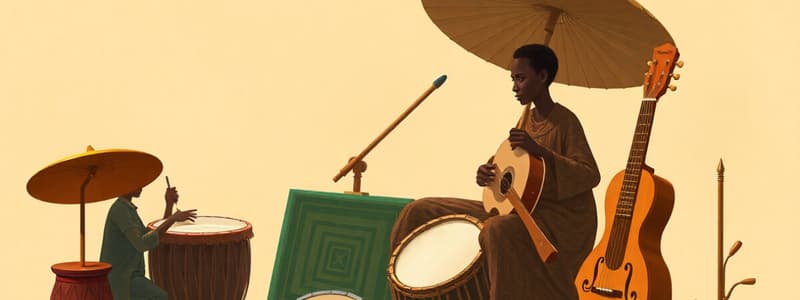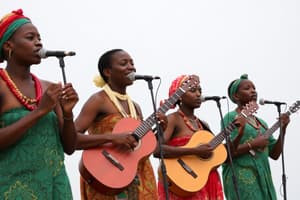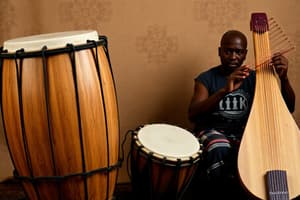Podcast
Questions and Answers
Which aspect of early African music is best exemplified by the interweaving rhythmic patterns found across diverse musical styles?
Which aspect of early African music is best exemplified by the interweaving rhythmic patterns found across diverse musical styles?
- Monorhythm
- Polyrhythms (correct)
- Call-and-response
- Homophony
How do Griots primarily preserve the history and traditions of their tribes in West Africa?
How do Griots primarily preserve the history and traditions of their tribes in West Africa?
- By constructing monumental architecture
- Via complex systems of trade and commerce
- Through songs and stories performed with instruments such as the kora (correct)
- Through elaborate written manuscripts
The Igbo people of Nigeria celebrate the yam harvest with festivals that prominently feature what?
The Igbo people of Nigeria celebrate the yam harvest with festivals that prominently feature what?
- Elaborate string ensembles
- Acrobatic dance performances
- The construction of yam-themed sculptures
- Udu clay drums played with hand-slapping and finger-tapping (correct)
How do Timbila bands of Southern Mozambique structure their performances?
How do Timbila bands of Southern Mozambique structure their performances?
What role do Ngomé drums play in Buganda culture?
What role do Ngomé drums play in Buganda culture?
Which of the following best explains how the pitch of a note is determined in aerophones?
Which of the following best explains how the pitch of a note is determined in aerophones?
The Surnai and Shawm are similar in that they are both...
The Surnai and Shawm are similar in that they are both...
A musician is seeking an instrument for its portability and suitability for nomadic life. Based on the provided information, which instrument would be the MOST appropriate choice?
A musician is seeking an instrument for its portability and suitability for nomadic life. Based on the provided information, which instrument would be the MOST appropriate choice?
How do the Harmonica and Accordion produce sound?
How do the Harmonica and Accordion produce sound?
Which instrument relies on varying lengths of bamboo strips woven together to produce music, and what is the music called?
Which instrument relies on varying lengths of bamboo strips woven together to produce music, and what is the music called?
Which of the following best describes the role of music in ancient societies?
Which of the following best describes the role of music in ancient societies?
The discovery of harps and cuneiform writings in the city of Ur provides insight into:
The discovery of harps and cuneiform writings in the city of Ur provides insight into:
What was the primary function of the cornu in Roman society?
What was the primary function of the cornu in Roman society?
How did Pythagoras contribute to the understanding of music theory?
How did Pythagoras contribute to the understanding of music theory?
The Delphic hymn tablet provides evidence of what aspect of ancient Greek music?
The Delphic hymn tablet provides evidence of what aspect of ancient Greek music?
What role did Confucius ascribe to music in early Chinese society?
What role did Confucius ascribe to music in early Chinese society?
What is the significance of the discovery of written music in Ugarit, Syria?
What is the significance of the discovery of written music in Ugarit, Syria?
How does music primarily contribute to the establishment and maintenance of social bonds within cultures?
How does music primarily contribute to the establishment and maintenance of social bonds within cultures?
Which of the following is a key factor in distinguishing musical instruments across different cultures?
Which of the following is a key factor in distinguishing musical instruments across different cultures?
If a previously unknown culture is discovered and they use instruments to create music, which aspect of their music would give the MOST insight into their cultural identity?
If a previously unknown culture is discovered and they use instruments to create music, which aspect of their music would give the MOST insight into their cultural identity?
A researcher aims to study how music impacts social cohesion in a multicultural society. What would be the MOST effective approach?
A researcher aims to study how music impacts social cohesion in a multicultural society. What would be the MOST effective approach?
Imagine a cultural exchange program where musicians from different countries collaborate on a musical piece. What outcome would best demonstrate the power of music in creating social bonds?
Imagine a cultural exchange program where musicians from different countries collaborate on a musical piece. What outcome would best demonstrate the power of music in creating social bonds?
Which of the following best captures the multifaceted nature of music, based on the provided ideas?
Which of the following best captures the multifaceted nature of music, based on the provided ideas?
Confucius' quote suggests that music provides a certain kind of pleasure that is essential to human nature. Which of the following is a valid conclusion from that statement?
Confucius' quote suggests that music provides a certain kind of pleasure that is essential to human nature. Which of the following is a valid conclusion from that statement?
The ideas suggest that music is found in venues, settings, and locations beyond a concert hall. Which of the following options would NOT exemplify this?
The ideas suggest that music is found in venues, settings, and locations beyond a concert hall. Which of the following options would NOT exemplify this?
Considering the multifaceted nature of music, how might a music therapist utilize music to help patients?
Considering the multifaceted nature of music, how might a music therapist utilize music to help patients?
The ideas suggest that music goes beyond pleasant experiences and emotions. Which of the following would NOT exemplify the expanded emotional possibilities of music?
The ideas suggest that music goes beyond pleasant experiences and emotions. Which of the following would NOT exemplify the expanded emotional possibilities of music?
How might the idea that it's not just one sound relate to the concept of cultural fusion in music?
How might the idea that it's not just one sound relate to the concept of cultural fusion in music?
What core idea relates to music being not just a steady beat?
What core idea relates to music being not just a steady beat?
The ideas suggest that music goes beyond live performance. Therefore, if a tree falls in a forest and no one is around to hear it, does it make music?
The ideas suggest that music goes beyond live performance. Therefore, if a tree falls in a forest and no one is around to hear it, does it make music?
Based on the ideas, why might encouraging individuals to create their own music be beneficial?
Based on the ideas, why might encouraging individuals to create their own music be beneficial?
A musician is considering switching from traditional silk strings to modern steel-nylon strings on their pipa. What adjustments would they MOST likely need to make to their playing technique?
A musician is considering switching from traditional silk strings to modern steel-nylon strings on their pipa. What adjustments would they MOST likely need to make to their playing technique?
Liu Fang is known for blending Western classical music with traditional Chinese music on the pipa. Which of these musical approaches would BEST exemplify this fusion?
Liu Fang is known for blending Western classical music with traditional Chinese music on the pipa. Which of these musical approaches would BEST exemplify this fusion?
Considering the classification of Chinese musical instruments based on the eight sounds, if one is repairing a damaged xun (ocarina), which material would be MOST appropriate to use?
Considering the classification of Chinese musical instruments based on the eight sounds, if one is repairing a damaged xun (ocarina), which material would be MOST appropriate to use?
In a Chinese orchestra, which combination of instruments BEST represents all eight sound categories?
In a Chinese orchestra, which combination of instruments BEST represents all eight sound categories?
What is the MOST likely reason that the strings of the pipa evolved from silk to steel wound with nylon?
What is the MOST likely reason that the strings of the pipa evolved from silk to steel wound with nylon?
If a composer wants to evoke a sense of ancient Chinese tradition primarily through percussive elements, which instrument family would be MOST suitable?
If a composer wants to evoke a sense of ancient Chinese tradition primarily through percussive elements, which instrument family would be MOST suitable?
How does the playing technique of the pipa reflect the design and materials of the instrument?
How does the playing technique of the pipa reflect the design and materials of the instrument?
What is the connection between the pipa and the lute?
What is the connection between the pipa and the lute?
Why might a pipa player choose to learn Western classical music in addition to traditional Chinese music?
Why might a pipa player choose to learn Western classical music in addition to traditional Chinese music?
Flashcards
Polyrhythms
Polyrhythms
Multiple rhythmic patterns that interweave in music.
Griots
Griots
Skilled musicians and storytellers preserving tribal history.
Udu Clay Drum
Udu Clay Drum
A traditional drum made by Igbo women, featuring unique playing techniques.
Timbila
Timbila
Broad-keyed wooden xylophones played by the Chopi tribe in Mozambique.
Signup and view all the flashcards
Mbira
Mbira
A thumb piano used by the Shona tribe, played during ceremonies.
Signup and view all the flashcards
Aerophones
Aerophones
Instruments played by blowing air into or across a tube or reed.
Signup and view all the flashcards
Harmonica
Harmonica
A small wind instrument played by blowing and sucking air across holes with reeds.
Signup and view all the flashcards
Clarinet
Clarinet
A woodwind instrument with a single reed that vibrates to create sound.
Signup and view all the flashcards
Bassoon
Bassoon
A woodwind instrument with a double reed; known for its deep sound.
Signup and view all the flashcards
Panpipes
Panpipes
A set of bamboo pipes of varying lengths, played by blowing across the top.
Signup and view all the flashcards
Cultural identity
Cultural identity
The shared characteristics and values that define a group.
Signup and view all the flashcards
Social bonds
Social bonds
Connections and relationships between individuals in a community.
Signup and view all the flashcards
Musical instruments
Musical instruments
Tools created to produce musical sounds, varied by culture.
Signup and view all the flashcards
Variety in music
Variety in music
A wide range of musical styles and forms across cultures.
Signup and view all the flashcards
Early music period
Early music period
The timeline of music history from 50,000 BCE to 1600 CE.
Signup and view all the flashcards
Pipa
Pipa
A four-stringed pear-shaped instrument from China, over 2,000 years old.
Signup and view all the flashcards
Liu Fang
Liu Fang
A renowned pipa player known for blending Western and Chinese music.
Signup and view all the flashcards
Pipa Playing Technique
Pipa Playing Technique
Played with nimble finger movements; uses plucking and fretting.
Signup and view all the flashcards
Pipa Strings
Pipa Strings
Originally soft silk, now made of steel and nylon for durability.
Signup and view all the flashcards
Chinese Orchestras
Chinese Orchestras
Ensembles featuring bowed strings, plucked strings, woodwinds, and percussion.
Signup and view all the flashcards
Eight Sounds of Instruments
Eight Sounds of Instruments
Chinese instruments categorized by eight materials: silk, bamboo, wood, etc.
Signup and view all the flashcards
Silk Instruments
Silk Instruments
Instruments using twisted silk strings, including harps and lutes.
Signup and view all the flashcards
Bamboo Instruments
Bamboo Instruments
Woodwind instruments like flutes and oboes made from bamboo.
Signup and view all the flashcards
Gourd Instruments
Gourd Instruments
Instruments like reed mouth organs made from dried gourds.
Signup and view all the flashcards
Ancient Music Sources
Ancient Music Sources
Music from ancient times is known through artifacts like paintings, pottery, and instruments.
Signup and view all the flashcards
Tortoiseshell Lyre
Tortoiseshell Lyre
An early string instrument supported by bull horns, significant in ancient music.
Signup and view all the flashcards
Hydraulis
Hydraulis
The first keyboard instrument invented in 246 BCE that used water and air pressure.
Signup and view all the flashcards
Pythagorean Music Theory
Pythagorean Music Theory
Pythagoras used a monochord to explore musical intervals and their mathematical relationships.
Signup and view all the flashcards
Delphic Hymn Tablet
Delphic Hymn Tablet
An ancient tablet containing the first known musical notation, dating back to 400 BCE.
Signup and view all the flashcards
Ancient Egyptian Instruments
Ancient Egyptian Instruments
The Egyptians created instruments like the lute, harp, and early flutes.
Signup and view all the flashcards
Written Music in Ugarit
Written Music in Ugarit
The oldest known written music found in Ugarit, dating back to around 1400 BCE.
Signup and view all the flashcards
Nature of Music
Nature of Music
Music is a form of pleasure essential to humanity.
Signup and view all the flashcards
Forms of Music
Forms of Music
Music can tell stories, evoke emotions, and express cultures.
Signup and view all the flashcards
Genres of Music
Genres of Music
Music includes various styles like upbeat, jazz, and hip-hop.
Signup and view all the flashcards
Emotional Impact
Emotional Impact
Music can be dramatic, spiritual, or rebellious, affecting emotions.
Signup and view all the flashcards
Music Availability
Music Availability
Music can be streamed, used in media, and shared through playlists.
Signup and view all the flashcards
Types of Music Ensemble
Types of Music Ensemble
Music is created by soloists, duets, or orchestras with diverse instruments.
Signup and view all the flashcards
Music in Nature
Music in Nature
Music exists in everyday sounds like birds, footsteps, and water.
Signup and view all the flashcards
Music Venues
Music Venues
Music is heard in various places like festivals, streets, and stores.
Signup and view all the flashcards
Creation of Music
Creation of Music
Anyone can create music, regardless of fame or expertise.
Signup and view all the flashcardsStudy Notes
Early African Music
- Early African music developed in various ways across many different tribes and, later, countries
- By looking at some modern-day African music traditions, we can see how these ancient varieties of music developed over time
- Common to many of them is an intertwining of different rhythmic patterns known as polyrhythms
West African Griots
- The griots are skilled musicians and storytellers who travel between the villages of Western Africa
- Griots preserve the history of their tribe in songs and stories
- They keep a record of ancestors, events, and tribal traditions
- An important role in society where little is written down
Udu Clay Drum of Nigeria
- Most of the Igbo people in the Niger are farmers
- The Igbo, which form the main staple of their diet
- Every year the Igbo celebrate the yam harvest with dances, and music
- The Igbo use drums as percussion instruments, such as the Udu clay drum
- The Udu drums are traditionally made by women and played with a combination of hand slapping and foot tapping
Timbila of Southern Mozambique
- The Chopi tribe plays a range of instruments but is famous for its broad-keyed xylophone called timbila
- The timbila is played by one performer who improvises the melody and is accompanied by other members of the group
- The timbila music is elaborate, syncopated, off-beat rhythm that encourages dancers to move around energetically
Berbers of North Africa
- The Berbers are indigenous to North Africa but generally supported by musicians playing instruments performed by bands of lively pipes or strings instruments
- At public festivals, many bands come together to perform
Kenyan Maasai Singing
- The Maasai people are nomadic instruments are distinctly different from other musical traditions
- The Maasai songs follow a pattern of call and response, where the first line is sung by the song leader and the men sing songs about bravery and hunting
- Maasai songs are chanted back and forth by the chorus, while women sing songs about family life and looking after the cattle
Ngome Drums of Buganda
- The Bantu peoples of central, eastern, and southern Africa use musical instruments called ngoma drums. The names in the Ugandan Kingdom of Buganda, each clan has their own unique drum beat.
- The ngoma drums are a symbol of great power and the most important drums belong to the king
Mbira of Zimbabwe
- The music of the Shona tribe often involves a small thumb piano known as the mbira
- The mbira is accompanied by another musician with a rattle
Studying That Suits You
Use AI to generate personalized quizzes and flashcards to suit your learning preferences.




